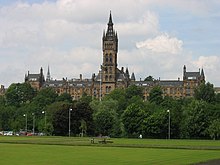Regius Professor of English Language and Literature, Glasgow
| Regius Chair of English Language and Literature University of Glasgow |
|
|---|---|
| Formation | 1861 |
| Founder | Queen Victoria |
| First holder | John Nichol |
| Website | www.gla.ac.uk/englishliterature |
The Regius Chair of English Language and Literature at the University of Glasgow was founded in 1861 by Queen Victoria, and is the only Regius Professorship in the Faculty of Arts.
The first professor appointed was John Nichol, a graduate of the University and Snell Exhibitioner at Balliol College, Oxford, and son of John Pringle Nichol, former Regius Professor of Astronomy at the University. Nichol had formerly been a coach at the University of Oxford, where along with A. V. Dicey, Vinerian Professor of English Law, philosopher Thomas Hill Green and poet Algernon Charles Swinburne he formed the Old Mortality Society, a literary discussion society. Whilst at Glasgow, Nichol maintained his strong reputation in literary criticism, lecturing at the same time at Oxford as well as tutoring privately across the country. He was also a supporter of the higher education of women. He left the Chair in 1889 and died in 1894. In 1885, the Nichol Prize for the most distinguished woman student in the Ordinary class of English Literature was founded by his sister, Lucy Jack.
Nichol was succeeded in 1889 by Andrew Cecil Bradley, a highly respected literary critic and noted scholar of Shakespeare, and brother of philosopher Francis Bradley. Bradley had studied at Balliol College, Oxford, and was at the time of his appointment a lecturer at University College Liverpool, now the University of Liverpool. In 1892, Bradley described his Glasgow students as "a set of savages whom it is a loathsome drudgery to teach," although he remained at the University until 1900, and in 1901 was elected Professor of Poetry at the University of Oxford. He delivered the 1907-1908 Gifford Lectures at the University. The Bradley Chair of English Literature was named after him, and his name was placed on the Memorial Gates erected to mark the University's quincentenary in 1951.
...
Wikipedia

